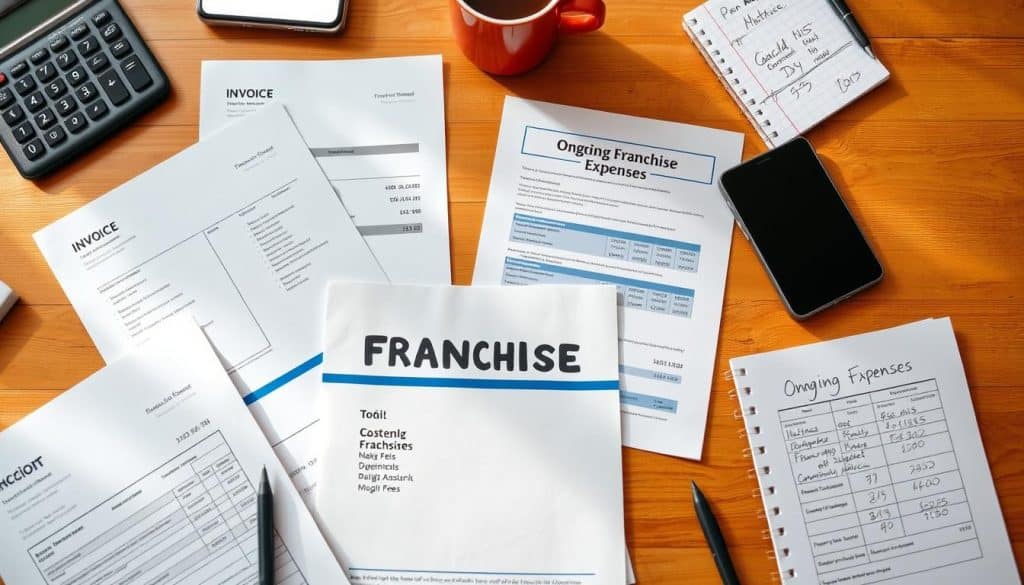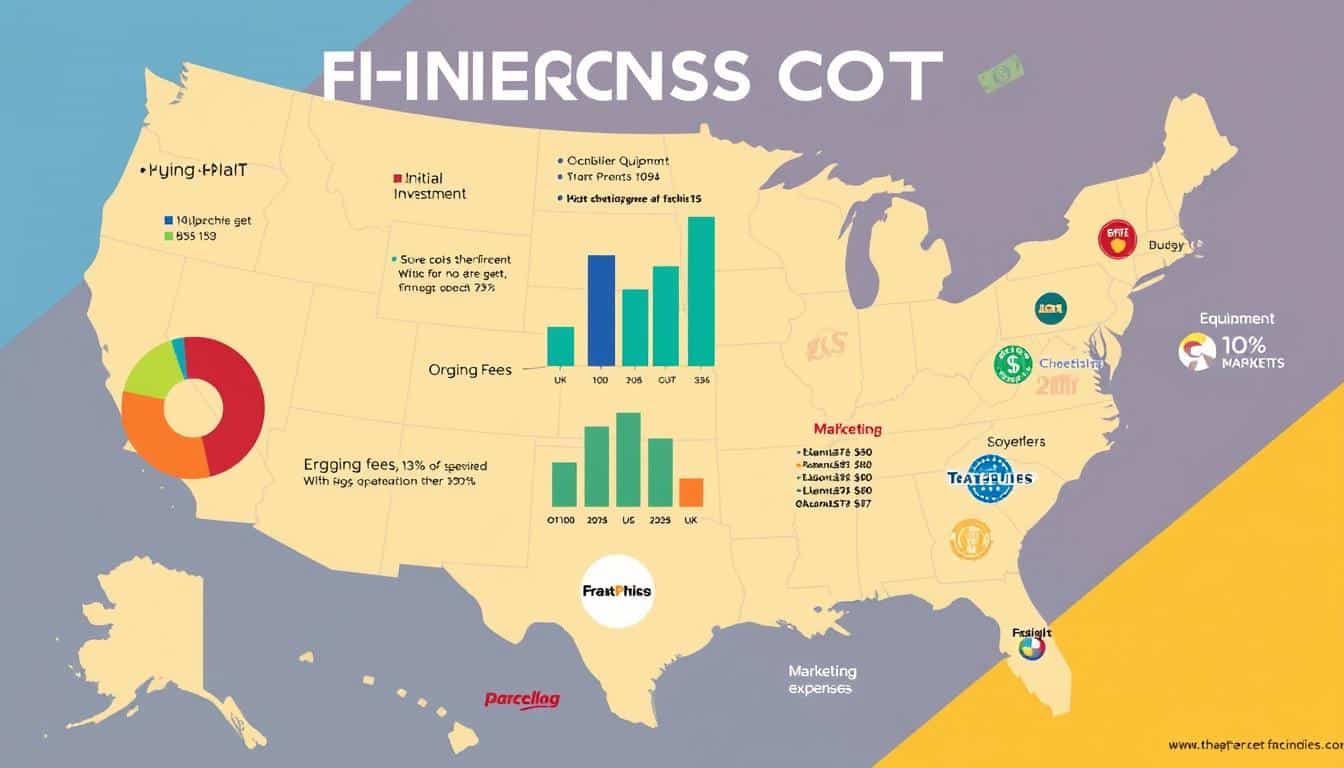Ever thought about the money needed to start a franchise? It’s more than just the first payment. It includes many other costs that new owners must think about. With about 61% of franchises making money, knowing the financial side can help entrepreneurs succeed.
Franchise costs change a lot. They depend on the business, where it’s located, and the franchisor’s rules. For example, starting a McDonald’s can cost over $2.3 million. Plus, there are ongoing fees and royalties to consider.
This deep dive into franchise costs aims to clear up the financial mysteries. It helps future franchise owners prepare for their journey. They can also look into different ways to finance their business and find hidden costs. For more details, check out this guide on franchise costs.
Key Takeaways
- Understanding franchise costs involves examining initial investment and ongoing expenses.
- The average income for franchise owners is approximately $102,910 per year.
- Initial franchise fees can range from $10,000 to over $2 million depending on the brand.
- Ongoing royalties typically range from 3% to 10% of sales.
- Location and business type significantly influence the financial requirements of a franchise.
- Proper budgeting and planning can unveil lucrative opportunities within franchising.
- Awareness of hidden costs is key to keeping profits up and business growing.
What Are Franchise Costs?
Franchise costs include many financial commitments for those wanting to start a franchise. It’s key to understand these costs to see the full picture of starting a franchise.
Initial Franchise Fee
The initial franchise fee is a one-time payment. It gives you access to the brand, its model, and support. This fee can be between $20,000 and $50,000. It depends on the brand’s reputation and how complex it is.
More famous brands usually ask for more money. The Franchise Disclosure Document (FDD) explains this fee. It also talks about other financial duties and promises from the franchisee.
Ongoing Royalties
Ongoing royalties are another big part of franchise costs. These fees are a percentage of what the franchise makes. They can be between 5% and 9%.
Franchisees pay these royalties to keep using the brand. They also get help and advice from the franchise. Many franchises also ask for money for advertising. This helps with national or regional marketing, boosting the brand’s image.
Factors Influencing Franchise Costs
Understanding the factors influencing franchise costs is key for investors. Franchise costs vary a lot. Location, business type, and franchise size are big factors.
Location
The location of a franchise is very important. It affects costs and success. Urban areas have high costs and competition, which can lower profits.
Suburban and rural areas might have less competition. This could lead to better profits if the business fits the local market. The cost of a franchise can also depend on where it’s located.
Business Type
The type of business affects costs. Fast-food franchises need a lot of money for equipment and real estate. But, they can make money quickly because people always want fast food.
Service-based franchises cost less to start. They might be more affordable for those with less money.
Size of Franchise
The size of the franchise impacts costs a lot. Bigger franchises cost more because they need more resources and space. But, they can make more money because they’re well-known.
Thinking about these factors helps investors choose wisely. They can match their money and goals with the right franchise.
Breakdown of Initial Investment
Starting a franchise comes with different costs that new owners need to think about. Knowing these costs helps understand the financial commitment. This commitment is often more than just the initial franchise fee.
Equipment and Inventory
Equipment and inventory costs make up a big part of the initial investment. The amount needed can change based on the franchise type. For example, a Quick Service Restaurant (QSR) might need a lot of kitchen equipment and supplies.
Most franchises list these costs in the Franchise Disclosure Document (FDD). This helps future franchisees know what they need for their business.
Real Estate Costs
Real estate costs are another big part of starting a franchise. Franchisees might lease or buy commercial space, which can be expensive. Many franchises also need specific changes to meet brand standards.
The location of the franchise is very important. It affects the cost and success of the business. So, franchisees should do a lot of research before deciding.
Marketing and Branding
Good marketing and branding are key for a franchise to succeed. Franchisees usually help pay for advertising campaigns. These costs are important for getting and keeping customers.
Knowing these marketing costs helps owners plan their budgets. It also helps them create effective promotional plans.
Ongoing Franchise Expenses
Understanding ongoing franchise expenses is key for long-term financial planning. These costs can greatly affect a franchisee’s profits and how well they operate.
Royalties and Advertising Fees
Franchisees often pay recurring royalty and advertising fees. For example, Creative Colors International (CCI) charges a 7.5% royalty fee. If sales hit $100,000, the royalty would be $7,500. They also pay a 1% advertising fee to support marketing.
These fees help keep the brand visible and drive sales. But they are a big part of the costs franchise owners must budget for.
Operating Costs
Operating costs include daily expenses like utilities, payroll, and supplies. These are vital for running the business well. As a franchise grows, these costs might increase with sales.
Franchisees need to be ready for these changes to stay profitable.
Renewal Fees
Renewal fees are another important ongoing expense. These fees are paid when the initial franchise agreement ends. They allow franchisees to continue working with the brand.
The cost of renewal fees varies by franchise. But planning for them is essential for keeping the brand and operations going.

Understanding the Franchise Disclosure Document (FDD)
The Franchise Disclosure Document, or FDD, is key for those thinking about investing in a franchise. It outlines the financial duties and commitments of future franchisees. This document gives a detailed look at what to expect in a franchise agreement. The FDD is about 300 pages long, packed with essential information for evaluating a franchise’s worth.
Key Cost Sections in the FDD
The FDD has several important cost sections. These sections reveal details on initial fees, ongoing royalties, and other financial commitments. They cover upfront costs, brand purchases, estimated investment amounts, and legal duties. It’s vital to review these sections carefully to grasp the financial aspects before committing.
Importance of Reviewing the FDD
Reviewing the FDD is very important for anyone looking at a franchise. There’s a legally required 14-day review period after getting the document. This time allows for a thorough understanding of its contents. Getting advice from a franchise attorney can uncover important details that might be missed.
Talking to the franchisor during this time can clear up any doubts. The FDD helps assess the franchisor’s financial health and the franchise’s overall value. This ensures a well-informed decision.
Financing Options for Franchise Costs
Getting the right financing is key for those looking to own a franchise. It’s important to know the different ways to fund your business. Each option has its own pros and cons that you should think about.
Traditional Loans
Traditional loans are a common choice for financing a franchise. Banks or credit unions offer these loans. You’ll need a good credit score, a solid business plan, and collateral.
While they can give you a lot of money, getting a loan can be tough. You need to be well-prepared before you apply.
Small Business Administration (SBA) Loans
SBA loans are great for small businesses, including franchises. The 7(a) Loan Program offers lower interest rates and longer repayment terms. This can help reduce the financial stress on new business owners.
With a strong business plan, SBA loans can greatly improve your chances of getting the money you need.
Franchisor Financing
Franchisor financing is another option to consider. Many franchisors offer financial help directly to their franchisees. This can include lower fees or direct funding.
Working with your franchisor can make it easier to get the money you need for your business.

Hidden Costs in Franchising
Franchising offers many opportunities for entrepreneurs. But, it also has hidden costs that can impact profits. It’s important to know these expenses for good financial planning.
Legal Fees
Legal fees for franchises can add up quickly. This is because of the complex agreements and local laws. Getting a lawyer to understand your obligations can cost between $1,500 and $5,000. Plus, there are extra fees for permits, which can be $2,000 to $10,000. Knowing these costs helps new franchisees avoid surprises.
Insurance Costs
Insurance is another big cost in franchising. Franchises need different types of insurance, like liability and property. These coverages protect against risks that could harm your business. It’s key to include these costs in your budget to stay safe and compliant.
Training and Support Expenses
Franchisors offer training and support, but there are extra costs. You might need to spend more on training to learn how to run your business well. Budgeting for ongoing training helps you succeed in your franchise. Knowing these hidden costs helps you plan better and increase your chances of making money.
Budgeting for Franchise Costs
Effective budgeting is key for a successful franchise. You need to plan for startup costs like franchise fees, equipment, and marketing. These costs vary by franchise, with fees from $40,000 to over $58,500. Ongoing fees are usually 4% to 15% of sales.
Creating an Initial Budget
Start by listing all necessary costs. This includes franchise fees, lease, and equipment. For example, lease costs are $20 to $30 per square foot. You’ll also need to budget for unexpected expenses, keeping $10,000 to $20,000 aside.
Long-Term Financial Planning
Planning for the long term is vital for growth. You should forecast earnings and save for future costs. This helps manage cash flow and ensures success in a competitive market.
Analyzing Return on Investment (ROI)
Understanding ROI is key for franchise owners aiming for long-term success. It helps assess financial performance and guides strategic decisions. It’s important to measure profits effectively, ensuring each investment brings real benefits.
Measuring Profits
Measuring profits means comparing net income to total investment over time. For franchisees, using the ROI formula is simple. It’s: Expected revenue minus Total investment and Operating Costs equals Net profit. Then, divide Net profit by Total initial investment and multiply by 100 to get ROI.
A franchise like Creative Colors International (CCI) shows how profit analysis guides future plans. It requires an investment of $101,380 to $121,911.
Understanding Break-Even Points
Finding the break-even point is vital for franchise success. It shows when revenues equal costs, a key sales benchmark. For example, a $500 marketing campaign can prevent an $800 sales drop.
Smart entrepreneurs should check their break-even analysis often. This helps adapt to market and tech changes, boosting ROI.
Common Misconceptions About Franchise Costs
When looking into franchising, people often face wrong ideas about costs. One big myth is that more money means more profit. But, profit depends on many things like where you are, how much competition you face, and how well you run the business. It’s key to look beyond the cost to see if you can really make money.
The Cost Equals Profitability
Also, many think all franchises cost a lot. But, there are affordable options out there. This shows that you don’t always need a lot of money to start a franchise. The cost can vary a lot, giving you choices based on your budget.
All Franchises Are Expensive
It’s important to clear up these wrong ideas about franchise costs. Learning about the real money side of franchising helps. While success isn’t easy and takes hard work, there are ways to make it easier, like getting help with money and support from the franchisor. Knowing the truth helps new franchise owners feel ready and sure about their choice.





